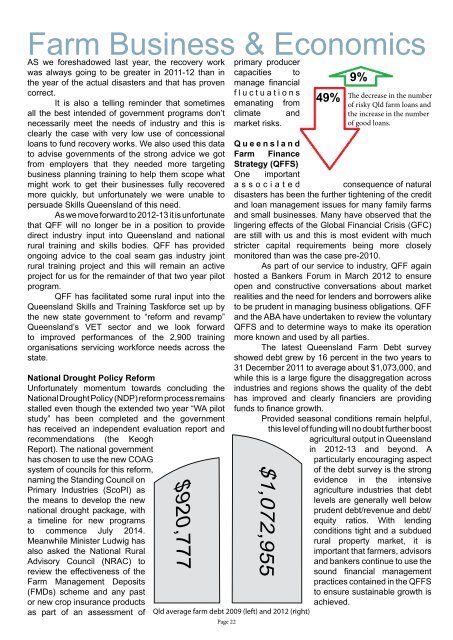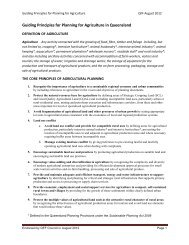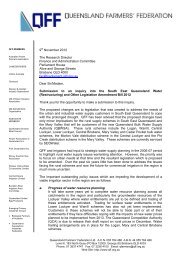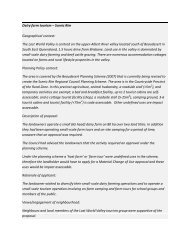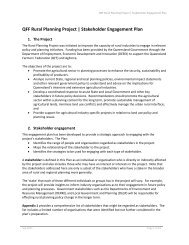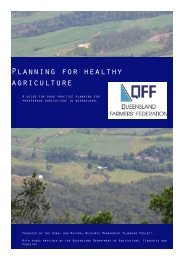here - Queensland Farmers Federation
here - Queensland Farmers Federation
here - Queensland Farmers Federation
Create successful ePaper yourself
Turn your PDF publications into a flip-book with our unique Google optimized e-Paper software.
Farm Business & Economics<br />
AS we foreshadowed last year, the recovery work<br />
was always going to be greater in 2011-12 than in<br />
the year of the actual disasters and that has proven<br />
correct.<br />
It is also a telling reminder that sometimes<br />
all the best intended of government programs don’t<br />
necessarily meet the needs of industry and this is<br />
clearly the case with very low use of concessional<br />
loans to fund recovery works. We also used this data<br />
to advise governments of the strong advice we got<br />
from employers that they needed more targeting<br />
business planning training to help them scope what<br />
might work to get their businesses fully recovered<br />
more quickly, but unfortunately we were unable to<br />
persuade Skills <strong>Queensland</strong> of this need.<br />
As we move forward to 2012-13 it is unfortunate<br />
that QFF will no longer be in a position to provide<br />
direct industry input into <strong>Queensland</strong> and national<br />
rural training and skills bodies. QFF has provided<br />
ongoing advice to the coal seam gas industry joint<br />
rural training project and this will remain an active<br />
project for us for the remainder of that two year pilot<br />
program.<br />
QFF has facilitated some rural input into the<br />
<strong>Queensland</strong> Skills and Training Taskforce set up by<br />
the new state government to “reform and revamp”<br />
<strong>Queensland</strong>’s VET sector and we look forward<br />
to improved performances of the 2,900 training<br />
organisations servicing workforce needs across the<br />
state.<br />
National Drought Policy Reform<br />
Unfortunately momentum towards concluding the<br />
National Drought Policy (NDP) reform process remains<br />
stalled even though the extended two year “WA pilot<br />
study” has been completed and the government<br />
has received an independent evaluation report and<br />
recommendations (the Keogh<br />
Report). The national government<br />
has chosen to use the new COAG<br />
system of councils for this reform,<br />
naming the Standing Council on<br />
Primary Industries (ScoPI) as<br />
the means to develop the new<br />
national drought package, with<br />
a timeline for new programs<br />
to commence July 2014.<br />
Meanwhile Minister Ludwig has<br />
also asked the National Rural<br />
Advisory Council (NRAC) to<br />
review the effectiveness of the<br />
Farm Management Deposits<br />
(FMDs) scheme and any past<br />
or new crop insurance products<br />
as part of an assessment of<br />
primary producer<br />
capacities to<br />
manage financial<br />
fluctuations<br />
emanating from<br />
climate and<br />
market risks.<br />
49%<br />
<strong>Queensland</strong><br />
Farm Finance<br />
Strategy (QFFS)<br />
One important<br />
associated<br />
consequence of natural<br />
disasters has been the further tightening of the credit<br />
and loan management issues for many family farms<br />
and small businesses. Many have observed that the<br />
lingering effects of the Global Financial Crisis (GFC)<br />
are still with us and this is most evident with much<br />
stricter capital requirements being more closely<br />
monitored than was the case pre-2010.<br />
As part of our service to industry, QFF again<br />
hosted a Bankers Forum in March 2012 to ensure<br />
open and constructive conversations about market<br />
realities and the need for lenders and borrowers alike<br />
to be prudent in managing business obligations. QFF<br />
and the ABA have undertaken to review the voluntary<br />
QFFS and to determine ways to make its operation<br />
more known and used by all parties.<br />
The latest <strong>Queensland</strong> Farm Debt survey<br />
showed debt grew by 16 percent in the two years to<br />
31 December 2011 to average about $1,073,000, and<br />
while this is a large figure the disaggregation across<br />
industries and regions shows the quality of the debt<br />
has improved and clearly financiers are providing<br />
funds to finance growth.<br />
Provided seasonal conditions remain helpful,<br />
this level of funding will no doubt further boost<br />
agricultural output in <strong>Queensland</strong><br />
in 2012-13 and beyond. A<br />
particularly encouraging aspect<br />
of the debt survey is the strong<br />
evidence in the intensive<br />
agriculture industries that debt<br />
levels are generally well below<br />
prudent debt/revenue and debt/<br />
equity ratios. With lending<br />
conditions tight and a subdued<br />
rural property market, it is<br />
important that farmers, advisors<br />
and bankers continue to use the<br />
sound financial management<br />
practices contained in the QFFS<br />
to ensure sustainable growth is<br />
achieved.<br />
Qld average farm debt 2009 (left) and 2012 (right)<br />
Page 22<br />
9%<br />
The decrease in the number<br />
of risky Qld farm loans and<br />
the increase in the number<br />
of good loans.


